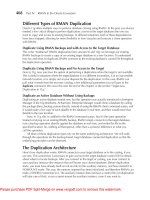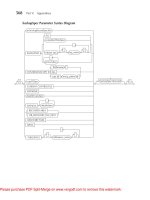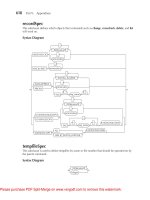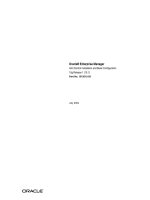Oracle Recovery Manager Overview and Configuration doc
Bạn đang xem bản rút gọn của tài liệu. Xem và tải ngay bản đầy đủ của tài liệu tại đây (234.75 KB, 31 trang )
9
Copyright © Oracle Corporation, 2002. All rights reserved.
Oracle Recovery Manager
Overview and Configuration
9-2
Copyright © Oracle Corporation, 2002. All rights reserved.
Objectives
After completing this lesson, you should be able to do
the following:
•
Identify the features and components of RMAN
•
Describe the RMAN repository and control file
usage
•
Describe channel allocation
•
Describe the Media Management Library interface
•
Connect to RMAN without the recovery catalog
•
Configure the RMAN environment
9-3
Copyright © Oracle Corporation, 2002. All rights reserved.
Recovery Manager Features
RMAN provides a flexible way to:
•
Back up the database, tablespaces, datafiles,
control files, and archive logs
•
Store frequently executed backup and recovery
operations
•
Perform incremental block-level backup
•
Skip unused blocks
•
Specify limits for backups
9-4
Copyright © Oracle Corporation, 2002. All rights reserved.
Recovery Manager Features
RMAN provides a flexible way to:
•
Detect corrupted blocks during backup
•
Increase performance through:
–
Automatic parallelization
–
Generation of less redo
–
Restricting I/O for backups
–
Tape streaming
•
Manage backup and recovery tasks
9-5
Copyright © Oracle Corporation, 2002. All rights reserved.
Recovery
Manager
(RMAN)
Server
session
(default)
Server
session
(polling)
Server
session
(channel)
MML
Server
session
(channel)
Server
session
(channel)
Target
database
Server
session
(rcvcat)
Recovery
catalog DB
Enterprise
Manager
Recovery Manager Components
Disk Disk
9-7
Copyright © Oracle Corporation, 2002. All rights reserved.
Using the Backup Management Wizards
9-8
Copyright © Oracle Corporation, 2002. All rights reserved.
RMAN Repository: Using the Control File
•
RMAN repository is metadata about target
database and backup and recovery operations.
•
RMAN repository is always stored in the control
file of the target database.
•
CONTROL_FILE_RECORD_KEEP_TIME determines
the minimum age in days of a record before it can
be overwritten.
•
The control file can grow in size.
9-9
Copyright © Oracle Corporation, 2002. All rights reserved.
Channel Allocation
RMAN
Channel (disk)
Server
Session
Channel (sbt)
Server
Session
Target
database
Disk
9-11
Copyright © Oracle Corporation, 2002. All rights reserved.
Automatic Channel Allocation
•
Change the default device type:
•
Configure parallelism for automatic channels:
•
Configure automatic channel options:
RMAN> CONFIGURE DEVICE TYPE DISK PARALLELISM 3;
RMAN> CONFIGURE DEFAULT DEVICE TYPE TO sbt;
RMAN> CONFIGURE CHANNEL DEVICE TYPE DISK
2> FORMAT = ‘/BACKUP/RMAN/%U';
RMAN> CONFIGURE CHANNEL DEVICE TYPE DISK
2> MAXPIECESIZE 2G;
9-12
Copyright © Oracle Corporation, 2002. All rights reserved.
Channel Allocation Using OEM
9-13
Copyright © Oracle Corporation, 2002. All rights reserved.
Manual Channel Allocation
•
BACKUP, COPY, RESTORE, and RECOVER commands
require at least one channel.
•
Allocating a channel starts a server process on the
target database.
•
Channels affect the degree of parallelism.
•
Channels write to different media types.
•
Channels can be used to impose limits.
RMAN> RUN {
2> ALLOCATE CHANNEL c1 TYPE disk
3> FORMAT = '/db01/BACKUP/usr0520.bak';
4> BACKUP DATAFILE '/db01/ORADATA/users01.dbf';}
9-15
Copyright © Oracle Corporation, 2002. All rights reserved.
Media Management
Recovery
Manager
Oracle server
session
Media
management
server software
Tape library or
single tape
Media
management
library
9-17
Copyright © Oracle Corporation, 2002. All rights reserved.
Types of Connections with RMAN
•
Target database
•
Recovery catalog database
•
Auxiliary database
–
Standby database
–
Duplicate database
–
TSPITR instance
9-18
Copyright © Oracle Corporation, 2002. All rights reserved.
Connecting Without a Recovery Catalog
•
Starting RMAN locally
•
Starting RMAN remotely
Server
process
(default)
Server
process
(polling)
UNIX: $ ORACLE_SID=DB01; export ORACLE_SID
$ rman target / as sysdba
Windows NT: C:\> set ORACLE_SID=DB01
C:\> rman target / as sysdba
rman target sys/target_pwd@DB01
Target
database
Recovery
manager
(RMAN)
9-20
Copyright © Oracle Corporation, 2002. All rights reserved.
Additional RMAN Command
Line Arguments
$ rman target sys/oracle
log $HOME/ORADATA/u03/rman.log append
@’$HOME/STUDENT/LABS/my_rman_script.rcv’
•
Writing RMAN output to a log file:
•
Executing a command file when RMAN is invoked:
$ rman target sys/oracle
log $HOME/ORADATA/u03/rman.log append
9-21
Copyright © Oracle Corporation, 2002. All rights reserved.
Recovery Manager Modes
•
Interactive mode
–
Use it when doing analysis
–
Minimize regular usage
–
Avoid using with log option
•
Batch mode
–
Meant for automated jobs
–
Minimize operator errors
–
Set the log file to obtain information
9-23
Copyright © Oracle Corporation, 2002. All rights reserved.
RMAN Commands
RMAN commands are of the following types:
•
Stand-alone
–
Executed only at the RMAN prompt
–
Executed individually
–
Cannot appear as subcommands within RUN
•
Job
–
Must be within the brackets of RUN
–
Executed as a group
•
Stand-alone or job
9-25
Copyright © Oracle Corporation, 2002. All rights reserved.
Job Command: Example
RUN command:
RMAN> RUN {
backup
incremental level 0
format ‘/u01/db01/backup/%d_%s_%p’
fileperset 5
(database include current controlfile);
sql ‘alter database archive log current’;
}
9-26
Copyright © Oracle Corporation, 2002. All rights reserved.
RMAN Configuration Settings
•
RMAN is preset with default configuration settings
•
Use the CONFIGURE command to:
–
Configure automatic channels
–
Specify the backup retention policy
–
Specify the number of backup copies to be created
–
Limit the size of backup sets
–
Exempt a tablespace from backup
–
Enable and disable backup optimization
9-27
Copyright © Oracle Corporation, 2002. All rights reserved.
The CONFIGURE Command
•
Configure automatic channels:
•
Implement retention policy by specifying a
recovery window:
•
Implement retention policy by specifying
redundancy:
RMAN> CONFIGURE RETENTION POLICY TO RECOVERY
2> WINDOW OF 7 days;
RMAN> CONFIGURE CHANNEL DEVICE TYPE DISK FORMAT
'/db01/BACKUP/%U';
RMAN> CONFIGURE RETENTION POLICY TO REDUNDANCY 2;
9-28
Copyright © Oracle Corporation, 2002. All rights reserved.
The CONFIGURE Command
•
Configure duplexed backup sets:
•
Configure backup optimization:
•
Use the CLEAR option to return to the default
value:
RMAN> CONFIGURE RETENTION POLICY CLEAR;
RMAN> CONFIGURE CHANNEL DEVICE TYPE sbt CLEAR;
RMAN> CONFIGURE DATAFILE BACKUP COPIES FOR
2> DEVICE TYPE disk TO 2;
RMAN> CONFIGURE BACKUP OPTIMIZATION ON;
9-29
Copyright © Oracle Corporation, 2002. All rights reserved.
The SHOW Command
•
Displays persistent configuration settings
•
Use the SHOW command to display:
–
Automatic channel configuration settings
–
Backup retention policy settings
–
Number of backup copies to be created
–
Backup set size limit
–
Tablespace excluded from backups
–
Backup optimization status
•
Use SHOW ALL to display all settings:
RMAN> SHOW ALL;
9-30
Copyright © Oracle Corporation, 2002. All rights reserved.
LIST Command Operations
•
Lists backup sets and copies of datafiles
•
Lists backup sets and copies of any datafile for a
specified tablespace
•
Lists backup sets and copies containing archive
logs for a specified range
9-31
Copyright © Oracle Corporation, 2002. All rights reserved.
The LIST Command
•
List backups of all files in the database:
•
•
List all backup sets containing the users01.dbf
datafile:
•
List all copies of datafiles in the SYSTEM
tablespace:
RMAN> LIST BACKUP OF DATAFILE
2> "/db01/ORADATA/u03/users01.dbf";
RMAN> LIST BACKUP OF DATABASE;
RMAN> LIST COPY OF TABLESPACE "SYSTEM";
9-32
Copyright © Oracle Corporation, 2002. All rights reserved.
The REPORT Command
•
Produces a detailed analysis of
the repository
•
Produces reports to answer:
–
Which files need a backup?
–
Which backups can be
deleted?
–
Which files are unrecoverable?









